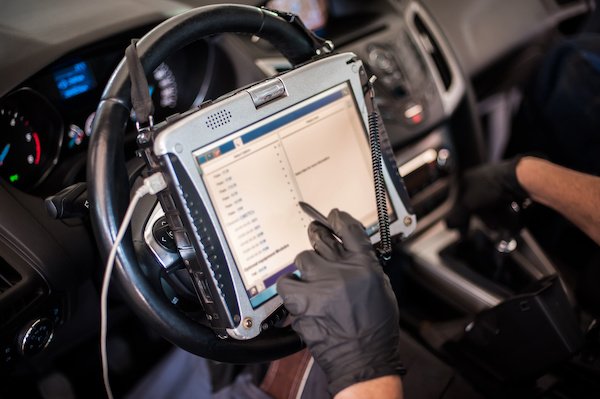
The automotive industry has undergone significant transformations over the past few decades, with technological advancements revolutionizing vehicle maintenance and repair. One of the most critical innovations in this space is auto diagnostics, a system that allows mechanics and vehicle owners to identify and troubleshoot issues efficiently.
Auto diagnostics have evolved from simple mechanical inspections to sophisticated computer-based systems that provide real-time data on a vehicle’s health. This article explores the history, technology, benefits, challenges, and future trends of auto diagnostics in the automotive sector.
1. The History of Auto Diagnostics
1.1 Early Mechanical Diagnostics
Before the advent of computerized systems, vehicle diagnostics relied heavily on manual inspections. Mechanics used their expertise to identify problems by listening to engine sounds, checking fluid levels, and performing physical tests. While effective for older, simpler vehicles, this method was time-consuming and often inaccurate for complex issues.
1.2 The Introduction of On-Board Diagnostics (OBD)
The On-Board Diagnostics (OBD) system marked a turning point in auto diagnostics. Introduced in the 1980s, OBD-I was the first standardized system that allowed vehicles to self-monitor engine performance. However, it was limited in scope and lacked uniformity across manufacturers.
1.3 OBD-II: The Game Changer
In 1996, the OBD-II standard became mandatory for all vehicles sold in the U.S. This system provided:
-
Standardized diagnostic trouble codes (DTCs)
-
Real-time monitoring of engine, transmission, and emissions systems
-
A universal connector (OBD-II port) for scanners
OBD-II revolutionized auto repair by enabling mechanics and even car owners to quickly identify issues without extensive manual inspections.
2. How Auto Diagnostics Work
Modern auto diagnostics rely on a combination of hardware and software to assess a vehicle’s condition.
2.1 Key Components
-
ECU (Engine Control Unit): The vehicle’s “brain” that monitors sensors and controls engine functions.
-
OBD-II Port: The access point for diagnostic tools.
-
Diagnostic Scanners: Devices that read and interpret fault codes.
-
Sensors: Measure parameters like oxygen levels, temperature, and pressure.
2.2 The Diagnostic Process
-
Scanning: A diagnostic tool is connected to the OBD-II port to retrieve trouble codes.
-
Code Interpretation: The scanner translates codes into readable information (e.g., “P0300” = random/multiple cylinder misfire).
-
Troubleshooting: Mechanics use the data to pinpoint the issue and recommend repairs.
-
Clearing Codes: After repairs, the codes are reset to verify the problem is resolved.
2.3 Types of Diagnostic Tools
-
Basic Code Readers: Affordable devices for reading and clearing codes.
-
Advanced Scan Tools: Provide live data, graphing, and manufacturer-specific codes.
-
Mobile Diagnostic Apps: Bluetooth-enabled scanners that work with smartphones (e.g., Torque Pro, BlueDriver).
-
Dealer-Level Tools: Professional-grade systems used by manufacturers (e.g., Ford’s IDS, GM’s Tech2).
3. Benefits of Auto Diagnostics
3.1 Faster and More Accurate Repairs
-
Reduces guesswork by providing precise error codes.
-
Shortens repair time, saving labor costs.
3.2 Preventive Maintenance
-
Detects minor issues before they become major problems.
-
Helps maintain optimal engine performance and fuel efficiency.
3.3 Cost Savings
-
Avoids unnecessary part replacements.
-
Empowers DIY enthusiasts to perform basic diagnostics.
3.4 Emission Compliance
-
Ensures vehicles meet environmental regulations by monitoring emissions systems.
3.5 Enhanced Vehicle Longevity
-
Proactive diagnostics extend engine and transmission life.
4. Challenges in Auto Diagnostics
Despite its advantages, auto diagnostics face several challenges:
4.1 Complexity of Modern Vehicles
-
Advanced systems (hybrid/electric cars, ADAS) require specialized tools.
-
Not all codes are straightforward; some require expert analysis.
4.2 Proprietary Software Limitations
-
Some manufacturers restrict access to certain diagnostic data, forcing reliance on dealerships.
4.3 False Positives
-
Sensors can sometimes trigger incorrect error codes, leading to unnecessary repairs.
4.4 Cybersecurity Risks
-
Connected diagnostic systems are vulnerable to hacking and data breaches.
5. The Future of Auto Diagnostics
5.1 AI and Machine Learning
-
Predictive diagnostics using AI to anticipate failures before they occur.
-
Self-learning algorithms that improve accuracy over time.
5.2 Over-the-Air (OTA) Diagnostics
-
Remote diagnostics and software updates via cloud connectivity (e.g., Tesla’s OTA updates).
5.3 Augmented Reality (AR) Assistance
-
AR glasses or apps guiding mechanics through complex repairs.
5.4 Blockchain for Secure Data Sharing
-
Tamper-proof diagnostic logs for maintenance history and recalls.
5.5 Integration with Autonomous Vehicles
-
Self-diagnosing and self-repairing systems in driverless cars.
6. Conclusion
Auto diagnostics have transformed vehicle maintenance, making it faster, cheaper, and more efficient. From basic OBD-I systems to AI-powered predictive analytics, the evolution of diagnostics continues to shape the automotive industry.
As cars become more advanced, diagnostic tools must keep pace with innovations in connectivity, AI, and cybersecurity. The future promises even smarter diagnostics, reducing downtime and enhancing vehicle reliability for both consumers and professionals.
For car owners, investing in a basic OBD-II scanner or using mobile diagnostic apps can save time and money. For mechanics, staying updated with the latest diagnostic technologies is essential to remain competitive in an ever-evolving industry.
Auto diagnostics are no longer just a repair tool—they are a cornerstone of modern automotive innovation.
